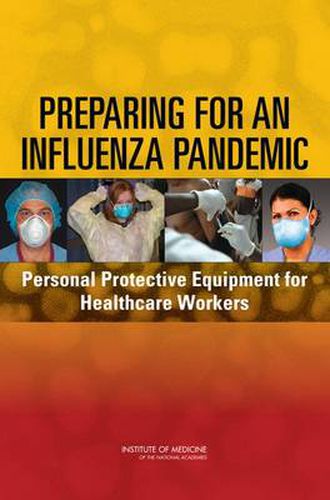Readings Newsletter
Become a Readings Member to make your shopping experience even easier.
Sign in or sign up for free!
You’re not far away from qualifying for FREE standard shipping within Australia
You’ve qualified for FREE standard shipping within Australia
The cart is loading…






During an influenza pandemic, healthcare workers will be on the front lines delivering care to patients and preventing further spread of the disease. As the nation prepares for pandemic influenza, multiple avenues for protecting the health of the public are being carefully considered, ranging from rapid development of appropriate vaccines to quarantine plans should the need arise for their implementation. One vital aspect of pandemic influenza planning is the use of personal protective equipment (PPE) - the respirators, gowns, gloves, face shields, eye protection, and other equipment that will be used by healthcare workers and others in their day-to-day patient care responsibilities. However, efforts to appropriately protect healthcare workers from illness or from infecting their families and their patients are greatly hindered by the paucity of data on the transmission of influenza and the challenges associated with training and equipping healthcare workers with effective personal protective equipment. Due to this lack of knowledge on influenza transmission, it is not possible at the present time to definitively inform healthcare workers about what PPE is critical and what level of protection this equipment will provide in a pandemic. The outbreaks of severe acute respiratory syndrome (SARS) in 2003 have underscored the importance of protecting healthcare workers from infectious agents. The surge capacity that will be required to reduce mortality from a pandemic cannot be met if healthcare workers are themselves ill or are absent due to concerns about PPE efficacy. The IOM committee determined that there is an urgent need to address the lack of preparedness regarding effective PPE for use in an influenza pandemic. Preparing for an Influenza Pandemic : Personal Protective Equipment for Healthcare Workers identifies that require expeditious research and policy action: influenza transmission research should become an immediate and short-term research priority so that effective prevention and control strategies can be developed and refined. The current paucity of knowledge significantly hinders prevention efforts; employer and employee commitment to worker safety and appropriate use of PPE should be strengthened. Healthcare facilities should establish and promote a culture of safety; and, an integrated effort is needed to understand the PPE requirements of the worker and to develop and utilize innovative materials and technologies to create the next generation of PPE capable of meeting these needs.
$9.00 standard shipping within Australia
FREE standard shipping within Australia for orders over $100.00
Express & International shipping calculated at checkout
During an influenza pandemic, healthcare workers will be on the front lines delivering care to patients and preventing further spread of the disease. As the nation prepares for pandemic influenza, multiple avenues for protecting the health of the public are being carefully considered, ranging from rapid development of appropriate vaccines to quarantine plans should the need arise for their implementation. One vital aspect of pandemic influenza planning is the use of personal protective equipment (PPE) - the respirators, gowns, gloves, face shields, eye protection, and other equipment that will be used by healthcare workers and others in their day-to-day patient care responsibilities. However, efforts to appropriately protect healthcare workers from illness or from infecting their families and their patients are greatly hindered by the paucity of data on the transmission of influenza and the challenges associated with training and equipping healthcare workers with effective personal protective equipment. Due to this lack of knowledge on influenza transmission, it is not possible at the present time to definitively inform healthcare workers about what PPE is critical and what level of protection this equipment will provide in a pandemic. The outbreaks of severe acute respiratory syndrome (SARS) in 2003 have underscored the importance of protecting healthcare workers from infectious agents. The surge capacity that will be required to reduce mortality from a pandemic cannot be met if healthcare workers are themselves ill or are absent due to concerns about PPE efficacy. The IOM committee determined that there is an urgent need to address the lack of preparedness regarding effective PPE for use in an influenza pandemic. Preparing for an Influenza Pandemic : Personal Protective Equipment for Healthcare Workers identifies that require expeditious research and policy action: influenza transmission research should become an immediate and short-term research priority so that effective prevention and control strategies can be developed and refined. The current paucity of knowledge significantly hinders prevention efforts; employer and employee commitment to worker safety and appropriate use of PPE should be strengthened. Healthcare facilities should establish and promote a culture of safety; and, an integrated effort is needed to understand the PPE requirements of the worker and to develop and utilize innovative materials and technologies to create the next generation of PPE capable of meeting these needs.